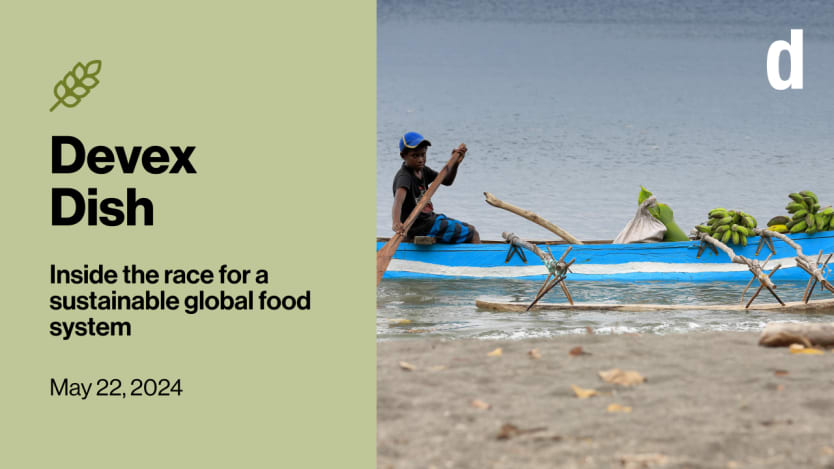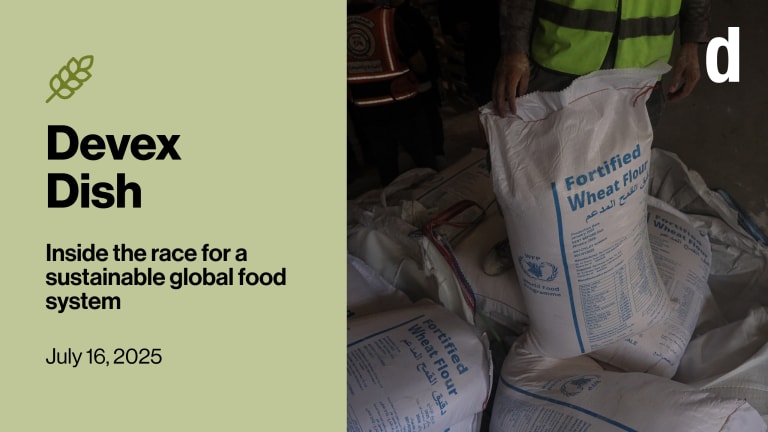Presented by CGIAR

In the disaster-prone Pacific, the island nation of Vanuatu is turning to traditional food preservation techniques to try and protect its food supply in the aftermath of cyclones and other natural disasters.
The islanders are looking to centuries-old practices such as burying breadfruit in underground pits where they can be preserved for more than 12 months. In one province, islanders have revived a technique of draining, burying, and mixing bananas with coconuts, which allows them to be kept for more than two years. Devex contributor Rebecca Root traveled there this spring to see it all up close.
This is a preview of Devex Dish
Sign up to this newsletter to get the inside track on how agriculture, nutrition, sustainability, and more are intersecting to remake the global food system in this weekly newsletter.
Such practices were once common among the Indigenous ni-Vanuatu people but have withered amid modernization, Rebecca writes. Yet they offer some security when disaster strikes. And it’s not just the cyclones wiping out wide swaths of crops that are a concern, but also the water contamination that can come in the wake of those storms, killing off any remaining fruits and vegetables. After a pair of cyclones struck Vanuatu last year two days apart, nearly 100% of fruit and forest trees, vegetables, coffee, coconut, and small livestock were damaged in the two worst-affected provinces.
Experts from NGOs and international donors are now looking to use modern technology to boost some of these practices.
One pilot project, run by Save the Children, is experimenting with using solar dryers to aid in dehydrating fruits and vegetables. The organizers are also sending excess crops to a local food supplier to be combined with meat and turned into ration packs that can be distributed in the aftermath of a disaster.
There are also efforts to cyclone-proof crop nurseries and to bolster water taro production, since the root vegetable can survive many weather disasters.
Where traditional techniques may have the advantage, though, is that they do not always require the same funding that is needed to scale the more modern strategies.
Read: How tech and tradition are cyclone-proofing Vanuatu’s food systems
Related reading: How bringing back indigenous crops can help solve the food crisis
Bet the farm
This week all eyes in Washington are on the farm bill — a $1.5 trillion piece of legislation that shapes food assistance both within the United States and abroad. While the legislation largely focuses on domestic policy, it also governs the operations of Food for Peace, a flagship food assistance program that distributes American-grown commodities across the globe.
The bill is supposed to be reauthorized every five years. But after lawmakers failed to do so in 2023, the existing legislation was extended until this September. Now, members of the Democratic-led Senate and Republican-led House have come up with their own ways to bring the farm bill forward. While the global development community is largely on board with the language proposed in the Senate, the proposal put forward by key House Rep. G.T. Thompson, a Republican from Pennsylvania, has garnered the opposite reaction.
“It risks undermining the program quality and reach of the Food for Peace Title II (FFP) program,” Bill O’Keefe, the executive vice president for mission, mobilization, and advocacy at Catholic Relief Services, said in a statement.
O’Keefe and others warn that the House’s version of the bill — which will be reviewed by lawmakers on Thursday — jeopardizes the programs that many communities count on. That’s due in large part to proposed restrictions on what Food for Peace funding should be spent on, and a mandate that at least 50% of funds should go toward U.S.-grown commodities and ocean freight.
Typically, that portion hovers around 40%, leaving leftover money to pay for in-land transportation, warehousing, and distribution costs in aid-receiving countries, Emily Byers, Save the Children’s managing director of global development policy, explained to Devex. The more money that’s mandated to go toward U.S. commodities, the less money there is for everything else — such as non-emergency programming for food-insecure communities, the staff required to actually distribute the food aid, and the scales, bags, and materials needed to store the commodities.
“I would imagine that this would hit the most vulnerable — the most remote, rural, and farthest from the ports, which are usually the ones with the fewest resources. They would be first to be cut off if the money wasn’t there to get the food to where it needed to go,” Byers said. “We need to be able to make that decision [on where to spend money] based on the program context, not based on what the spreadsheet here in Washington says.”
Devex reporter Elissa Miolene is following the bill’s twists and turns, so watch this space for updates.
Background reading: With US farm bill uncertain, aid groups try to protect Food for Peace
+ Devex Pro members can also read about other foreign aid issues that face challenges in the U.S. Congress this year. Not yet gone Pro? Read the article and all our exclusive reporting and analyses by starting your 15-day free trial today.
A new table
Bringing home the bacon
Your next job?
Urban Agrifood Systems Coordinator
Food and Agriculture Organization
Italy
If we are what we eat, then it’s probably a good idea to know exactly what it is that we’re putting in our mouths.
That’s the goal of the Periodic Table of Food Initiative, a Rockefeller Foundation-led project that is looking to determine the biomolecular composition of foods. That information could inform both the health care that people receive and improve planetary health, according to the project’s partners, which include the American Heart Association and the Alliance of Bioversity International and CIAT.
And there’s much to uncover: An estimated 26,000 biomolecules occur in plants, according to Rockefeller, and the vast majority are unknown.
The project hopes that by identifying and better understanding the biomolecules that are present in foods — and then standardizing that data globally — doctors will be better able to treat patients, including by recommending specific diets that respond to individual health needs, Devex contributor Helen Morgan writes.
And an improved awareness of the nutrients in foods might also encourage a switch toward more regenerative agriculture, which focuses on improving soil health. Researchers also suspect it will lead to the production of more nutrient-dense foods.
Read: Periodic Table of Food fills 'black box' of data on food composition
+ ICYMI, Devex is officially on Telegram and WhatsApp! Join our channels to receive updates on the latest global development news directly to your mobile device.
Chew on this
In Europe, where temperatures are increasing at twice the global rate, the European Parliament has responded by rolling back regulations that seek to address biodiversity losses. [Land & Climate Review]
Relief supplies are now reaching Gazans through a U.S.-built floating pier, but aid organizations warn that the route is costly and limited in capacity. [Financial Times]
It’s time to bring traditional and indigenous knowledge into discussions about how to reform agri-food systems, a recent study argues. [New Food]
Cocoa farmers in West Africa are racing to map their plots in order to meet a deadline for a European Union law that aims to prevent deforestation by tracing the origins of any cocoa that makes its way into the bloc. [The Wall Street Journal]
Elissa Miolene contributed to this edition of Devex Dish.








